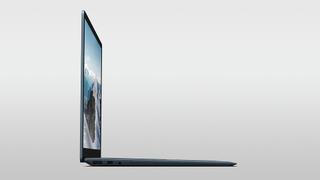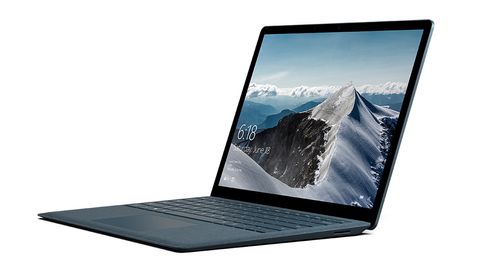Microsoft's Surface Laptop is perhaps the least exciting of the Surface range for creative professionals. It’s virtually a direct competitor to the Apple MacBook; offering very similar specs, but with the addition of a touchscreen – which can of course be used with the (sold separately) Surface Pen.
Before you open it up, the Surface Laptop feels very much like the Surface Book, only slimmer, a little more tapered and a bit lighter. Its edges are relatively angular, but it feels like a great piece of industrial design.
Open it up, though, and you’re presented with something a little different. The entire keyboard area is made of fabric.
Surface Laptop build
Admittedly, it’s not any old fabric – it isn't like working on a laptop covered in your grandma’s pyjamas. This is Alcantara fabric: the same kind of strokable, stain-resistant covering used on luxury car seats. The best way to describe it is ‘faux suede’.
It does feel a little odd at first, but it's strangely pleasing and tactile. Using it for long periods of time is comfortable, as it’s softer than the metal on the Surface Book and MacBook. The fabric layer tapers off slightly towards the edge of the laptop, adding to the ergonomics when your palms are rested on it.

The keyboard has another trick up its sleeve – it’s also the speaker. To save space for grilles and to make the Surface Laptop as thin and lightweight as possible, the ‘Omnisonic’ speakers are below the keyboard.
And the Surface Laptop has impressive audio quality. It wasn’t at all muffled, as we had half-expected.
The Surface Laptop is touchscreen, but unlike the Surface Pro or Surface Book, it isn’t a hybrid – you can’t remove the screen to use it as a tablet. Sure, you can still sketch on the screen using the Surface Pen (£100 extra) in any creative app, or take notes in Windows Ink, but the traditional laptop form factor doesn’t exactly lend itself to this way of working for longer amounts of time.
Surface Laptop specs
The specs of the 13.5-inch Surface Laptop aren’t too shabby across the board. But like all of Microsoft’s Surface machines, price rises dramatically when you start getting into what a creative pro needs for daily design work.
The Core i7 with 16GB RAM, a 512GB SSD and Intel Iris graphics comes in at £2,150. That's a considerable amount of cash – just £200 less than a 15-inch MacBook Pro with Touch Bar (which has a Core i7 with a smaller SSD but with Thunderbolt 3 ports).
The mid-range Surface Laptop competes directly with the same-priced MacBook, although the Surface has a 1.5-inch larger screen, a USB port and a Mini DisplayPort (rather than just a USB-C).

So it’s a little tricky to decipher who the Surface Laptop is for. Is it a student machine? Is it a daily laptop? Is it a creative machine? Well, depending on the configuration, it could be any of these.
The base spec machine seems like excellent value – and you get a laptop that looks ace and will perform well. But for over £2,000 for a top-end model, we’ll take a Surface Book with Performance Base and NVIDIA graphics. All day long.
And we’d definitely take the i5/128GB SSD/8GB RAM Surface Book at £1,449 over the £1,249 Surface Laptop with a larger 256GB SSD (but lesser screen – see below) at the same price – simply due to the fact you can detach the screen on the Surface Book and use it as a digital sketchpad.
Surface Laptop touchscreen
So the Surface Laptop screen. Like the rest of the Surface range, it's excellent – bright, sharp and, as a touchscreen, very responsive. At 2256x1504 pixels at 201ppi, it’s a little behind the stunning screen of the Surface Book (3000x2000 pixels at 267ppi) and that of the 12.3-inch Surface Pro (2736x1824 at 267ppi).
The ppi isn’t noticeable in daily use – you’re never going to make out a pixel on these screens. But those after more real estate will favour the larger resolution of both the Surface Book and Pro.
Microsoft quotes the Surface Laptop at 14.5-hours battery life. And like with the Surface Pro, we got a whole day out of the Laptop, with a combination of video, browsing, a bit of sketching, some tweeting and a bit of layout work in InDesign.

Surface Laptop performance
The Surface Laptop comes with Windows 10 S – meaning you can only install apps from the Windows Store (essentially to increase security). Obviously this is a major consideration for creative pros when Adobe’s products are not on there. You can, until March 2018, easily upgrade to the full version of Windows 10 for free.
There’s nothing at all wrong with the Surface Laptop. It’s a slim, very light (1.25kg), great-looking, well-built machine with a lovely tactile keyboard and a great screen. And we love the four different colours it comes in – the Cobalt Blue is particularly nice.
But if you're looking for versatility, the hybrid Surface Pro and Surface Book offer more for creative professionals.


